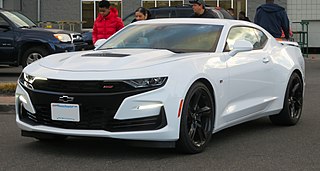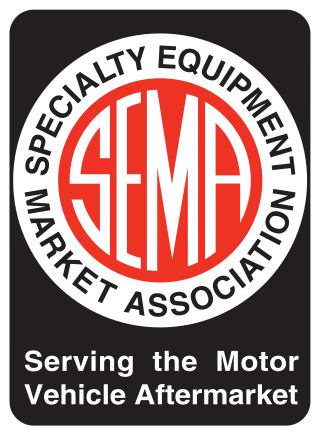Related Research Articles

Cosworth is a British automotive engineering company founded in London in 1958, specialising in high-performance internal combustion engines, powertrain, and electronics for automobile racing (motorsport) and mainstream automotive industries. Cosworth is based in Northampton, England, with facilities in Cottenham, England, Silverstone, England, and Indianapolis, IN, US.

The Ford Sierra is a mid-size car or large family car manufactured and marketed by Ford Europe from 1982–1993, designed by Uwe Bahnsen, Robert Lutz and Patrick le Quément — and noted for its aerodynamic styling producing a drag coefficient of 0.34, a significant improvement over its predecessors.

The Chevrolet Camaro is a mid-size American automobile manufactured by Chevrolet, classified as a pony car. It first went on sale on September 29, 1966, for the 1967 model year and was designed to compete with the Ford Mustang. The Camaro shared its platform and major components with the Firebird, produced by General Motors' Pontiac division that was also introduced for 1967.

The Pontiac Firebird is an American automobile built and produced by Pontiac from the 1967 to 2002 model years. Designed as a pony car to compete with the Ford Mustang, it was introduced on February 23, 1967, five months after GM's Chevrolet division's platform-sharing Camaro. This also coincided with the release of the 1967 Mercury Cougar, Ford's upscale, platform-sharing version of the Mustang. The name "Firebird" was also previously used by GM for the General Motors Firebird series of concept cars in the 1950s.

Pony car is an American car classification for affordable, compact, highly styled coupés or convertibles with a "sporty" or performance-oriented image. Common characteristics include rear-wheel drive, a long hood, a short decklid, a wide range of options to individualize each car and use of mass-produced parts shared with other models. The popularity of pony cars is largely due to the launch of the Ford Mustang in 1964.
The F platform, or F-body, was General Motors' rear-wheel drive pony car automobile platform from 1967 until 2002. It was based partially on the GM X platform, which was used for compact applications instead of the sporting intent of the F-Body. The only two vehicles to have been built using the F-Body platform are the Chevrolet Camaro and the Pontiac Firebird. The fourth character in the Vehicle Identification Number for an F-body car is "F" on model year 1985 and up vehicles. Earlier Camaros and Firebirds had differing VIN codes, but are now commonly referred to as F-bodies.
The T-56 six speed manual transmission has been used in a wide range of vehicles from General Motors, Dodge, and Ford Motor Company. The transmission was originally designed and built by BorgWarner for the Dodge Viper later being used by GM in 1992 for the generation II and later engines, but from 1998 was built by Tremec, though nothing changed internally. The T-56 has been succeeded by the Tremec TR-6060 transmission in many former T-56 applications, as well as applications requiring greater strength than the T-56 could offer.
Turbo-Hydramatic or Turbo Hydra-Matic is the registered tradename for a family of automatic transmissions developed and produced by General Motors. These transmissions mate a three-element turbine torque converter to a Simpson planetary geartrain, providing three forward speeds plus reverse.

Specialty Equipment Market Association (SEMA) of the automobile aftermarket was formed in 1963 by Paul Schiefer, Roy Richter, Ed Iskenderian, Els Lohn, Willie Garner, Bob Hedman, Robert E. Wyman, John Bartlett, Phil Weiand Jr, Al Segal, Dean Moon, and Vic Edelbrock Jr. Now it consists of 6,383 companies worldwide, bringing together aftermarket manufacturers, original equipment manufacturers (OEM), media, car dealers, specialty equipment distributors, installers, retailers, and restoration specialists.
The AOD is a four-speed automatic transmission, with the 4th gear as overdrive. Introduced in 1980, it was Ford's first four-speed automatic overdrive transmission. The gearset design is based on the Ford "X" automatic transmissions used during the 1950s, '60s, and '70s. The AOD replaced many of Ford's older transmissions, such as the C4, C5, and light duty applications of the FMX.
Vehicles made by American Motors Corporation (AMC) and Jeep incorporated a variety of transmissions and transfer case systems. This article covers transmissions used in the following vehicle models and years:

The Tremec TR-6060 six-speed manual transmission features six forward speeds and one reverse speed. It is derived from the Tremec T-56 6-speed manual transmission. As usual, the forward helical cut gears are synchronized. However, the reverse gear operates through a fully synchronized constant-mesh system. The TR-6060 contains removable wear pads on the shift forks, and uses aluminum alloys for the main case, extension housing, and clutch housing. It is a double overdrive transmission. The TR-6060 is manufactured by TREMEC and is rated for 430 lb⋅ft (580 N⋅m) to 650 lb⋅ft (880 N⋅m) of torque, depending on gearing.

The third-generation Chevrolet Camaro is an American pony car which was introduced for the 1982 model year by Chevrolet. It continued to use General Motors' F-body platform and produced a "20th Anniversary Commemorative Edition" for 1987 and "25th Anniversary Heritage Edition" for 1992. These were also the first Camaros with factory fuel injection, four-speed automatic transmissions, five-speed manual transmissions, four-cylinder engines, 16-inch wheels, and hatchback bodies. For 1987 a convertible Camaro was reintroduced, converted by ASC in relatively small numbers. The third-generation Camaro continued through the 1992 model year.
The cars in Miami Vice mainly involve the Ferrari Daytona Spyder and the Ferrari Testarossa, but also include other automobiles driven by the characters on the show. Currently one Daytona is in a private collection and the other is on display at the Volo Auto Museum; the Ferrari Testarossa stunt car resides in Kingsport, Tennessee and is owned by Carl Roberts of Carl Roberts Motor Group. Today, one of the hero cars is part of The Witvoet collection owned by Bastiaan Witvoet in Belgium.

The third-generation Mustang was produced by Ford from 1979 until 1993. Built on Ford's Fox platform, it is commonly referred to as the Fox body Mustang. It evolved through several sub-models, trim levels, and drivetrain combinations during its production life. It underwent updates for the 1987 model year and seemed destined for replacement with a front-wheel drive Mazda platform. However, company executives were swayed by consumer opinion and the rear-wheel drive Mustang stayed, while the front-wheel drive version was renamed the Ford Probe. Enthusiasts group the generation into two segments: the 1979–1986 cars, with their quad headlight arrangement, and the 1987–1993 cars, with their aerodynamic composite headlamps and front fascia styling. Production ended with the introduction of the fourth-generation Mustang (SN-95) for the 1994 model year.

The fifth-generation Ford Mustang (S197) is a pony car manufactured and marketed by Ford from 2004 to 2014, for the 2005 to 2014 model years. Assembly took place at the Flat Rock Assembly Plant in Flat Rock, Michigan. The fifth generation began with the 2005 model year, and received a facelift for the 2010 model year.

The TREMEC TR-3160 is a six-speed RWD manual transmission that features six forward speeds and one reverse speed. It is manufactured by TREMEC.
The Ford–GM 10-speed automatic transmission is part of a joint venture between Ford Motor Company and General Motors to design and engineer two transmissions: a longitudinal 10-speed transmission and a transverse 9-speed trans-axle. Each company manufactures its own unique version of the transmissions in its own factories. The 10-speed transmission was designed by Ford, while the 9-speed transmission was designed by GM.
References
- 1 2 3 Smart, Jim (June 22, 2015). "Everything You Ever Wanted To Know About The T-5 Five-Speed". Motor Trend. Retrieved 12 October 2022.
- 1 2 "HOW TO: Identify your T5 is a World class or Non-World class version". Modern Driveline. Retrieved 12 October 2022.
- 1 2 "Tremec T-5 Service Manual, Bulletin number TRSM-T5-0510" (PDF). Tremec Corporation. Retrieved 12 October 2022.
- 1 2 3 "The many different faces of the T5". Modern Driveline. 9 August 2019. Retrieved 12 October 2022.
- ↑ O'Clair, Jim (September 23, 2018). "T-5 Transmission swaps". Hemmings. Retrieved 12 October 2022.
- ↑ "T5 Swaps for Early Fords". Ford Muscle. September 2000. Retrieved 12 October 2022.